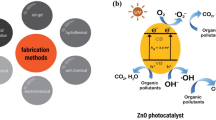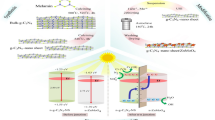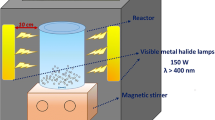Abstract
In order to improve the visible light response, N-doping ZnS (N-ZnS) nanospheres with Zn vacancy and porous surface were prepared by a simple one-pot hydrothermal method. Characterizations and density functional theory simulations showed excellent visible light response of N-ZnS. N-doping introduced impurity energy levels, which led to orbital hybridization and changed the original dipole moment. The presence of ortho Zn vacancy (O-Znv) can effectively reduce e−-h+ recombination and photocorrosion. Furthermore, O-Znv caused lattice distortion (twisted the -S-Zn-N-(O-Znv)-S-Zn–S- chemical bond chain), resulting in “vacancy effect” to accelerate e− flow. Under visible light, the photocatalytic degradation efficiency of tetracycline (TC) and 2,4-dichlorophenol (2,4-DCP) was 90.31% and 60.84%, respectively. TOC degradation efficiency was 31.4% and 25.6%, respectively. Combined with Fukui index and LC–MS methods, it was found that TC and 2,4-DCP were degraded under the constant attack of active substances such as ·OH. This work can provide a reference for the application of catalytic materials in the field of visible light photocatalysis.









Similar content being viewed by others
References
Ahadi M, Tehrani MS, Azar PA et al (2016) Novel preparation of sensitized ZnS nanoparticles and its use in photocatalytic degradation of tetracycline. Int J Environ Sci Technol 13:2797–2804
Ahluwalia S, Prakash NT, Prakash R et al (2016) Improved degradation of methyl orange dye using bio-co-catalyst Se nanoparticles impregnated ZnS photocatalyst under UV irradiation. Chem Eng J 306:1041–1048
Ai CZ, Li J, Yang L et al (2020) Transforming Photocatalytic g-C3N4/MoSe2 into a Direct Z-Scheme System via Boron-Doping: A Hybrid DFT Study. Chem Sus Chem 13:4985–4993
Alafif ZO, Anjum M, Ansari MO et al (2019) Synthesis and characterization of S-doped-rGO/ZnS nanocomposite for the photocatalytic degradation of 2-chlorophenol and disinfection of real dairy wastewater. J Photochem Photobiol a-Chem 377:190–197
Al-Kahtani AA, Alshehri SM, Naushad M et al (2019) Fabrication of highly porous N/S doped carbon embedded with ZnS as highly efficient photocatalyst for degradation of bisphenol. Int J Biol Macromol 121:415–423
Badellino C, Rodrigues CA, Bertazzoli R (2006) Oxidation of pesticides by in situ electrogenerated hydrogen peroxide: Study for the degradation of 2,4-dichlorophenoxyacetic acid. J Hazard Mater 137:856–864
Bhushan M, Jha R (2020) Surface activity correlations of mesoporous 3-D hierarchical ZnS nanostructures for enhanced photo and electro catalytic performance. Appl Surf Scie 528:146988
Booth A, Aga DS, Wester AL (2020) Retrospective analysis of the global antibiotic residues that exceed the predicted no effect concentration for antimicrobial resistance in various environmental matrices. Environ Int 141:105796
Chestnoy N, Harris TD, Hull R et al (1986) Luminescence and photophysics of cadmium sulfide semiconductor clusters: the nature of the emitting electronic state. J Chem Phys 90:3393–3399
Deng ZX, Wang C, Sun XM et al (2002) Structure-directing coordination template effect of ethylenediamine in formations of ZnS and ZnSe nanocrystallites via solvothermal route. Inorg Chem 41:869
Deng B, Zhu YQ, Li JL et al (2020) Low temperature synthesis of highly bright green emission CuInS2/ZnS quantum dots and its application in light-emitting diodes. J Alloys Comp 845:155400
Devkota S, Shisir D, Mehul P et al (2020) A study of n-doping in self-catalyzed GaAsSb nanowires using GaTe dopant source and ensemble nanowire near-infrared photodetector. Nanotechnology 31(50):505203
Elsayed MA, Gobara M, Elbasuney S (2017) Instant synthesis of bespoke nanoscopic photocatalysts with enhanced surface area and photocatalytic activity for wastewater treatment. J Photochem Photobiol, A 344:121–133
Fang SY, Zhang P, Gong JL et al (2020) Construction of highly water-stable metal-organic framework UiO-66 thin-film composite membrane for dyes and antibiotics separation. Chem Eng J 385:123400
Feng W, Yuan J, Zhang L et al (2020) Atomically thin ZnS nanosheets: facile synthesis and superior piezocatalytic H2 production from pure H2O. Appl Catal B Environ 277:119250
Gnanasekaran L, Rajendran S, Priya AK et al (2021) Photocatalytic degradation of 2,4-Dichlorophenol using bio-green assisted TiO2-CeO2 nanocomposite system. Environ Res 195:110852
Guo Y, Li DF, Hu CW et al (2001) Photocatalytic degradation of aqueous organocholorine pesticide on the layered double hydroxide pillared by paratungstate an ion: Mg12Al6(OH)36(W7O24)·4H2O. Appl Catal B 30(3):337–349
Guo J, Khan S, Cho SH et al (2019) Preparation and immobilization of zinc sulfide (ZnS) nanoparticles on polyvinylidene fluoride pellets for photocatalytic degradation of methylene blue in wastewater. Appl Surf Sci 473:425–432
Guo J, Huang M, Meng L et al (2021) Synergistic impacts of Cu2+ on simultaneous removal of tetracycline and tetracycline resistance genes by PSF/TPU/UiO forward osmosis membrane. Environ Res 195:110791
Guo SY, Luo HH, Li Y (2021) Structure-controlled three-dimensional BiOI/MoS2 microspheres for boosting visible-light photocatalytic degradation of tetracycline. J Alloys Comp 852:157026
Hao XQ, Wang YC, Zhou J et al (2018) Zinc vacancy-promoted photocatalytic activity and photostability of ZnS for efficient visible-light-driven hydrogen evolution. Appl Catal B 221:302–311
Hoang K, Latouche C, Jobic S (2018) Defect energy levels and persistent luminescence in Cu-doped ZnS. Comput Mater Sci 163(1):63–67
Humayun M, Hu ZW, Khan A et al (2019) Highly efficient degradation of 2,4-dichlorophenol over CeO2/g-C3N4 composites under visible-light irradiation: detailed reaction pathway and mechanism. J Hazard Mater 364:635–644
Jabeen U, Shah SM, Khan SU (2017) Photo catalytic degradation of Alizarin red S using ZnS and cadmium doped ZnS nanoparticles under unfiltered sunlight. Surfaces and Interfaces 6:40–49
Jiang XC, Xie Y, Lu J et al (2001) Simultaneous In situ formation of ZnS nanowires in a liquid crystal template by γ-irradiation. Chem Mater 13:1213
Jothibas M, Manoharan C, Jeyakumar SJ et al (2018) Synthesis and enhanced photocatalytic property of Ni doped ZnS nanoparticles. Solar Energy 159:434–443
Kamali M, Costa ME, Aminabhavi TM et al (2019) Sustainability of treatment technologies for industrial biowastes effluents. Chem Enaineerina J 370:1511–1521
Kurnia F, Ng YH, Amal R et al (2016) Defect engineering of ZnS thin films for photoelectrochemical water-splitting under visible light. Sol Energy Mater Sol Cells 153:179–185
Kuroiwa Y, Aoyagi S, Sawada A et al (2001) Evidence for Pb-O covalency in tetragonal PbTiO3. Phys Rev lett 87(21):217601
Li Y, Zhou S, Chen Z et al (2013) Luminescence properties of Br-doped ZnS nanoparticles synthesized by a low temperature solid-state reaction method. SciVerse ScienceDirect 39:5521–5525
Li WT, Huang WZ, Zhou H et al (2015) Synthesis of Zn2+ doped BiOCl hierarchical nanostructures and their exceptional visible light photocatalytic properties. J Alloy Compd 638:148–154
Li XX, Chen ZY, Chen Z et al (2020) An experimental and theoretical study on the photoluminescence of O and Br Co-doped ZnS quantum dots synthesized by a solid-state reaction method. J Alloys Comp 845:155405
Li YW, Liu F, Li M et al (2020b) Study on adsorption coupling photodegradation on hierarchical nanostructured g-C3N4/TiO2/activated carbon fiber composites for toluene removal. J Sol-Gel Sci Technol 93:402–418
Lin YJ, Ni WS (2016) Effects of sulfide treatment on the electrical, photoluminescent and structural properties of ZnS films. J Lumin 172:286–289
Liu C, Ji Y, Tan T (2013) One-pot hydrothermal synthesis of water-dispersible ZnS quantum dots modified with mercaptoacetic acid. J Alloy Compd 570:23–27
Liu F, Fan FT, Lv YC et al (2016) Research progress on adsorption of refractory organic pollutant by graphene-containing composite Materials. Acta Petrolei Sinica (petroleum Processing Section) 32(04):856–866
Madkour M, Sagheer FA (2017) Au/ZnS and Ag/ZnS nanoheterostructures as regenerated nanophotocatalysts for photocatalytic degradation of organic dyes. Opt Mater Express 7:158–169
Masoud SN, Mohammad RLE, Fatemeh D (2009) Controllable synthesis of wurtzite ZnS nanorods through simple hydrothermal method in the presence of thioglycolic acid. J Alloy Compd 475:782–788
Matos J, Fierro V, Monta AR et al (2016) High surface area microporous carbons as photoreactors for the catalytic photodegradation of methylene blue under UV-vis irradiation. Appl Catal A 517:1–11
Muruganandham M, Kusumoto Y (2009) Synthesis of N, C codoped hierarchical porous microsphere ZnS as a visible light-responsive photocatalyst. J Phys Chem C 113:16144–16150
Panigrahi S, Basu S, Praharaj S et al (2007) Synthesis and size-selective catalysis by supported gold nanoparticles: study on heterogeneous and homogeneous catalytic process. J Phys Chem C 111:4596–4605
Peng H, Liu DX, Zheng XG et al (2019) N-doped carbon-coated ZnS with sulfur-vacancy defect for enhanced photocatalytic activity in the visible light region. Nanospheres 9(12):1657
Perdew JP, Burke K, Ernzerhof M (1996) Generalized gradient approximation made simple. Phys Rev Lett 77:3865
Rosas-Laverde NM, Pruna A, Busquets-Mataix D et al (2018) Improving the properties of Cu2O/ZnO heterojunction for photovoltaic application by graphene oxide. Ceram Int 1016:14–21
Sakthivel P, Jayasri T, Madhumitha J et al (2018) Influence of Cd on optical and photoluminescence behavior of Zn0.98-xCdxMn0.02S quantum dots under Ar atmosphere. Optik 154:74–82
Sakthivel P, Rasu KK, Venkatesan GKDP et al (2020) Influence of Ag+and Mn2+ ions on structural, optical and photoluminescence features of ZnS quantum dots. Spectrochim Acta Part A Mol Biomol Spectrosc 241:118666
Sharma K, Kumar P, Verma G et al (2020) Optical properties of transition metal doped ZnS nanoparticles in PVK based nanocomposite films. Optik 206:164375
Tie L, Sun R, Jiang H et al (2019) Facile fabrication of N-doped ZnS nanospheres for efficient photocatalytic performance of organic pollutant removal and H2 production. J Alloys Comp 807:151670
Wang X, Yao J (2017) Improvement of the self-consistent-charge density-functional-tight-binding theory by a modified Mullike charge. Theor Chem Acc 136:124
Wang G, Huang B, Zhujie L et al (2015) Synthesis and characterization of ZnS with controlled amount of S vacancies for photocatalytic H2 production under visible light. Sci Rep 5:1–7
Wang C, Zhang Y, Wang W et al (2018) Enhanced photocatalytic degradation of bisphenol A by Co-doped BiOCl nanosheets under visible light irradiation. Appl Catal B 221:320–328
Wang SJ, He FT, Zhao XL et al (2019) Phosphorous doped carbon nitride nanobelts for photodegradation of emerging contaminants and hydrogen evolution. A Catal B Environ 257:11793
Wang JL, Liu X, Li CS et al (2020) Fabrication of perylene imide-modified NH2-UiO-66 for enhanced visible-light photocatalytic degradation of tetracycline. J Photochem Photobiol A Chem 401:112795
Wang S, Ji B, Zhang M et al (2021) Tetracycline-induced decoupling of symbiosis in microalgal-bacterial granular sludge. Environ Res 197:111095
Wu M, He X, Jing BH et al (2020) Novel carbon and defects co-modified g-C3N4 for highly efficient photocatalytic degradation of bisphenol A under visible light. J Hazard Mater 384:121323
Xia Y, Li Q, Lv KL et al (2017) Superiority of graphene over carbon analogs for enhanced photocatalytic H2-production activity of ZnIn2S4. Appl Catal B 206(5):344–352
Xiong HF, Dong SS, Zhan J et al (2018) Roles of an easily biodegradable co-substrate in enhancing tetracycline treatment in an intimately coupled photocatalytic-biological reactor. Water Res 136:75–83
Xu LJ, Wang JL (2012) Fenton-like degradation of 2,4-dichlorophenol using Fe3O4 magnetic nanoparticles. Appl Catal B 123–124:117–126
Xu R, Zhao YH, Han QZ et al (2020) Computer-aided blended extractant design and screening for co-extracting phenolic, polycyclic aromatic hydrocarbons and nitrogen heterocyclic compounds pollutants from coal chemical wastewater. J Clean Prod 277(20):122334
Yang W, Mortier WJ (1986) The use of global and local molecular parameters for the analysis of the gas-phase basicity of amines. J Am Chem Soc 108:5708–5711
You Y, Qu KQ, Shi C et al (2020) Binder-free CuS/ZnS/sodium alginate/rGO nanocomposite hydrogel electrodes for enhanced performance supercapacitors. Int J Biol Macromol 162:310–319
Zhang R, Wang Q, Li Q et al (2011) First-principle calculations on optical properties of C-N-doped and C-N-codoped anatase TiO2. Physica B 406(18):3417–3422
Zhang MX, Xu LH, Qi CL et al (2019) Highly effective removal of tetracycline from water by hierarchical porous carbon: batch and column adsorption. Ind Eng Chem Res 58:20036–20046
Zhang T, Liu Y, Jiang S et al (2020) Bacitracin-assisted synthesis of spherical BiVO4 nanoparticles with C doping for remarkable photocatalytic performance under visible light. CrystEngComm 10:1812–1821
Zhao H, Liu X, Dong Y et al (2019) A special synthesis of BiOCl photocatalyst for efficient pollutants removal: new insight into the band structure regulation and molecular oxygen activation. Appl Catal B Environ 256:117872
Zheng L, Zheng Y, Chen C et al (2009) Network structured SnO2/ZnO heterojunction nanocatalyst with high photocatalytic activity. Inorg Chem 48:1819–1825
Zhou YS, Chen G, Yu YG et al (2015) An efficient method to enhance the stability of sulphide semiconductor photocatalysts: a case study of N-doped ZnS. Royal Soc Chem 17:187
Zhu YC, Bando YS, Xue DF (2003) Spontaneous growth and luminescence of zinc sulfide nanobelts. Appl Phys Lett 82:1769
Zimbron AJ, Reardon FK (2005) Hydroxyl free radical reactivity toward aqueous chlorinated phenols. Water Res 39:865–869
Zou Z, Xu H, Li D et al (2019) Facile preparation and photocatalytic activity of oxygen vacancy rich BiOCl with 001 exposed reactive facets. Appl Surf Sci 463:1011–1018
Funding
This work was supported by CNPC safety and environmental protection key technology research and promotion project (2017D-4613) and Sub project of national science and technology major project (2016ZX05040-003).
Author information
Authors and Affiliations
Contributions
Conceptualization, data curation, investigation, methodology, supervision, writing: Benjie Zhu, Guofei Jiang, Can Kong, Junzhi Sun.
Project administration, resources, supervision, writing-review and editing: Fang Liu, Yongqiang Wang, Chaocheng Zhao, Chunshuang Liu.
Corresponding author
Ethics declarations
Ethics approval and consent to participate
Not applicable.
Consent for publication
Not applicable.
Competing interests
The authors declare no competing interests.
Additional information
Responsible Editor: Sami Rtimi
Publisher's note
Springer Nature remains neutral with regard to jurisdictional claims in published maps and institutional affiliations.
Supplementary Information
Below is the link to the electronic supplementary material.
Rights and permissions
About this article
Cite this article
Zhu, B., Jiang, G., Kong, C. et al. Photocatalytic degradation of organic pollutants in water by N-doping ZnS with Zn vacancy: enhancement mechanism of visible light response and electron flow promotion. Environ Sci Pollut Res 29, 58716–58729 (2022). https://doi.org/10.1007/s11356-022-19852-1
Received:
Accepted:
Published:
Issue Date:
DOI: https://doi.org/10.1007/s11356-022-19852-1




